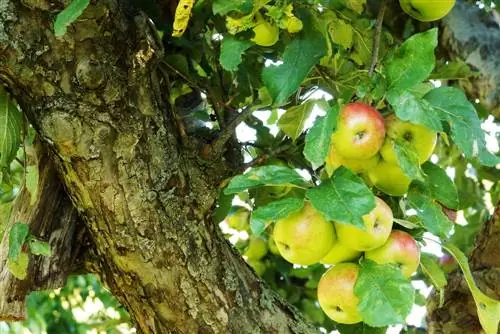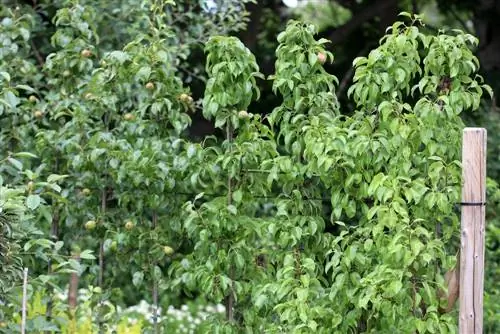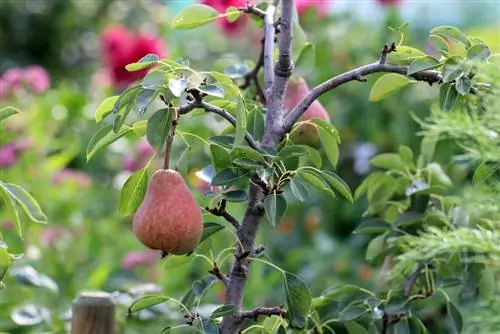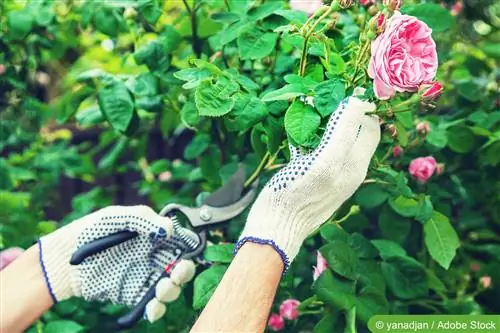- Author admin [email protected].
- Public 2023-12-17 03:39.
- Last modified 2025-06-01 06:48.
Thanks to their extensive root system, fruit trees are obviously able to get the water and nutrients they need from the soil themselves. However, the fact is that they cannot survive without the helping hand of humans. This is how you can care for fruit trees throughout the year.
Spring
If young fruit tree seedlings are planted at the beginning of the year - ideally in March or April - the ideal conditions should be created. It is therefore necessary in advance to pay attention to the quality of the material, its resistance and its promising appearance. In addition, the soil conditions in particular must be of optimal nature. When planting the seedlings, it is definitely advisable not only to add plenty of water, but also to include fertilizer. Ideally, a long-term fertilizer is used in this context, which continuously releases the nutrients to the roots of the trees over a period of around three to six months.
Of course, in the “young years” it is still important to water the trees regularly. The root system is simply not strong enough to get the individually required amounts of water and nutrients from the soil on its own.
Summer
Of course, regular watering is also essential during the summer. Such comprehensive “all-round care” can create the perfect basis for long-term he althy growth. Ultimately, only really he althy, robust and resilient plants are able to withstand any pest infestation. With a view to possible illnesses, fungal or pest infestations, regular care is essential all year round. Specific pest control measures - as natural as possible, for example with chrysanthemum extract etc. - can achieve considerable success. In addition, diseased branches, leaves or flowers should be removed manually regularly. In the course of this, it is still important to remove dead shoots.
Autumn
Care is required when it comes to the right cut. Experience has shown that pruning is done right at the beginning of the year, in spring, or shortly before the onset of winter, in late autumn. Hobby gardeners do not have to cut back the branches of their trees in the same way as is the case in commercial plantations. Because in the home garden it's not just about the richest possible harvest yield, but also a full tree crown is a real eye-catcher in the outdoor areas. In the commercial sector, however, the small branches are usually cut back as much as possible in spring or autumn in order to ensure a better and more sustainable supply of nutrients to the fruit-bearing branches. Cutting away everything that is “superfluous”, however, is frowned upon in the hobby gardening segment - and certainly does not contribute to the beautification of the botanical paradise at home.
Winter
As soon as winter approaches and perhaps after the final cut has been carried out, the crown should be protected against ice, snow, frost and the like with a cover as part of protective fruit tree care. This measure is particularly necessary if pruning was actually carried out a few weeks previously and there are still “wounds” on the tree. In this way, frost damage can be explicitly prevented. Of course, you should avoid watering fruit trees during the winter season as the plants are now in “rest mode”. Nevertheless, “too much” water in the roots or in the meridians could cause them to freeze and the affected areas to die by spring. By the way, you should also avoid fertilizing the trees again before the upcoming “hibernation”. This would only stimulate growth, but this would involve additional energy expenditure. However, the tree needs this energy in order to fully bloom again next spring and - little by little - to produce the first flowers again. Always with a view to a delicious fruit harvest.
Fruit Tree Care Tips
- Fruit trees are planted in autumn or spring.
- You should pay attention to an optimal location and regular fertilization.
- Professional pruning of fruit trees is one of the basics of fruit tree care. It should be carried out properly as this is a prerequisite for he althy growth and a productive harvest. Diseased sections are cut off down to the he althy wood. It is recommended to close the wounds with tree wax after the cutting measures.
It is important to remove emerging wild shoots. These shoots are cut off below the grafting point. Fruit trees should receive regular pruning for the first three years after planting. All branches and twigs growing inside the crown are cut out. Last year's shoots are shortened by around a third. In the following years it is sufficient to remove older and dead branches. Balanced fertilization ensures abundance of flowers and good fruit production. In spring, mature compost can be worked into the soil and the tree disc can be mulched regularly throughout the year.
Fruit tree canker is a fungal disease. It shows itself through bulging growths and cracks in the bark, and branches above it die. Aphids, spider mites, blood lice, powdery mildew, scab and fire blight (which is reportable) are also common problems in fruit tree care. Specialist retailers have an extensive range of products available to eliminate unwanted fruit tree diseases. In autumn, the trunk of fruit trees is cleaned of moss, loose bark, algae and hidden pests. To do this, the trunk is brushed vigorously with a root brush. Afterwards, the trunk can be painted. If the trunk is regularly coated with a broth of natural substances, the bark is cared for and cell formation is promoted.






